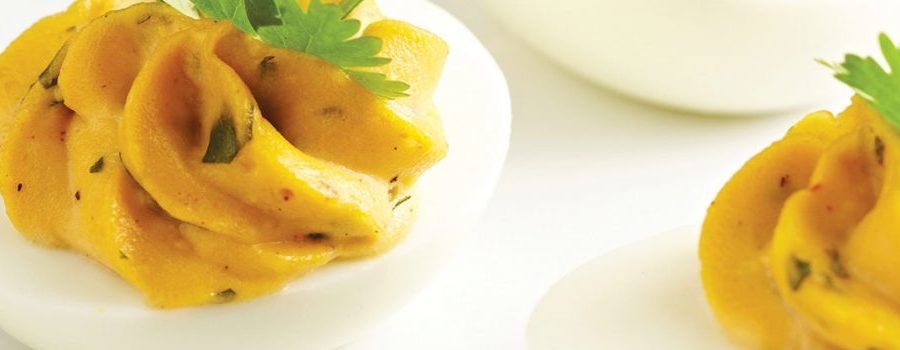Fried Eggs
A perennial breakfast favourite, fried eggs are also fantastic any time of day, served next to — or on top of — dishes like arugula salad for lunch or fried rice for dinner.
To make fried eggs, heat some fat, such as butter, olive oil or bacon fat, in a non-stick skillet over medium-low heat. Crack in a couple of large eggs and cook until the whites are opaque, three to four minutes. (Hint: Fresh eggs hold their shape better.)
If you’re a sunny-side-up person, you’re done. For over-easy, gently flip the eggs with a thin, flexible spatula and cook for one minute more; for over-medium, two minutes more; and for over-hard, three minutes more.
Tip: To create the golden, lacy edges of a crispy fried egg, crank the heat up to medium-high as you melt the fat. Cook the eggs for one minute at the higher heat, and then reduce to medium-low and cook to desired doneness.
Try them in:
Basic Eggs Over Easy
Basic Eggs Sunny Side Up
Croque Midi with Salami, Goat Cheese & Fried Egg
Poached Eggs
Cooked in a simmering liquid, usually water, poached eggs have a soft texture and are typically prepared so that the whites are fully cooked but the yolks are still runny.
Bring a saucepan of water to a gentle simmer — bubbles should only just be rising to the surface — and add 1 tbsp (30 mL) white vinegar. Crack an egg into a small glass bowl, being careful not to break the yolk.
For a single serving, try the whirlpool method, which creates a compact egg shape without feathered edges. Using the handle of a wooden spoon, stir the water in one direction until it is spinning smoothly. Gently drop the egg into the centre of the whirlpool.
(For multiple servings, do not stir: Simply dunk the bowl into the water for a few seconds before slipping in the egg, and then repeat for each egg.)
Cover and simmer for three minutes to get a runny yolk and up to five minutes for a firm yolk. Carefully remove eggs with a slotted spoon, blot the bottom of the spoon on a clean kitchen towel to remove excess water, and serve immediately.
A restaurant staple for eggs Benedict, sous-vide poached eggs are sealed in plastic and cooked in a water bath. To make something similar at home, crack an egg onto oiled plastic wrap and tie with kitchen string or a twist-tie to form a bundle. Cook in boiling water for about three minutes. Add this gorgeous runny egg to a kale caesar salad or float it on cream of asparagus soup.
Tip: Need to make eggs Benny for a crowd? Pour a spoonful or two of cold water into each cup of a muffin tin, and then crack one egg into each. Bake at 350°F (180°C) until the whites are opaque but the yolks are still runny, about 12 minutes. Heaven!
Try them in:
Classic Eggs Benedict with Hollandaise Sauce
Poached Eggs Over Potato Hash
Boiled Eggs
This is one preparation method for which older eggs are better, as they’re much easier to peel. Prep time depends on personal preference, so experiment at home to find your perfect timing.
First, place eggs in a saucepan and add enough cold water to cover, plus about 1 inch (2.5 cm). Any number of eggs can be boiled at once, so long as they remain in a single layer on the bottom of the saucepan; size up or down the saucepan or the number of eggs to meet your needs. Cover and bring to a boil over high heat.
To make hard-boiled eggs, remove the pan from the heat once the water has started boiling, and let the pan stand, covered, for 18 minutes for medium eggs, 20 minutes for large eggs and 23 minutes for extra-large eggs. Drain and rinse under cold running water to keep a grey-green film from forming around the yolks (which is harmless but not very appetizing). For soft-boiled eggs, reduce the standing time to three minutes.
Tip: To make devilled eggs, halve hard-boiled eggs lengthwise, and then mash the yolks with mayo, mustard and seasonings (such as hot sauce, chopped fresh dill or minced olives) until creamy. Pipe or spoon into the whites and garnish with chopped fresh herbs. Devilled eggs disappear fast — trust us — so make a double batch.
Try them in:
No Limits Devilled Eggs
Caesar Egg Salad with Oka and Grilled Greens
Scrambled Eggs
A comfort-food classic, scrambled eggs are at home in everything from brekkies to burritos to stir-fries.
For basic scrambled eggs, crack two or three large eggs per person into a bowl and whisk with salt and pepper until frothy. Brush a non-stick skillet with oil or melt a spoonful of butter over medium-high heat. Reduce the heat to medium-low, pour in the eggs and keep everything moving with a plastic or silicone spatula.
The more often you stir, the smaller the curds will be. If you like your scrambled eggs moist, transfer to a plate while they still have a liquidy sheen; otherwise, continue cooking until fluffy and no longer shiny. Serve immediately.
Variations: Many people like to add a few tablespoons of cream or milk to their beaten eggs before cooking — experiment to see what you prefer. The texture will also vary depending on the speed and temperature of cooking: a slow, low-temperature cook will result in custard-like eggs, while cooking eggs on higher heat will make them firmer and drier.
Tip: Dress up a humble scramble with a handful each of chopped fresh herbs (try dill, parsley or cilantro) and shredded, crumbled or grated cheese (think cream cheese, aged Gouda, blue or Parmesan).
Try them in:
Basic Scrambled Eggs
Grilled Steak & Egg Sliders
Easy Breakfast Tacos
Omelettes
First, set out your fillings. Fresh herbs, diced ham or bacon, shredded rotisserie chicken, sliced mushrooms and shredded cheese are all excellent.
Use two or three large eggs per person. For each omelette, crack eggs into a bowl that’s big enough to let you beat the mixture without sloshing it over the side. Add about 1 tbsp (15 mL) milk, cream or water and a pinch of salt, if desired. (Or, if you like an eggier texture and taste, don’t add any liquid.) With a fork, beat the mixture until well combined.
In a small non-stick skillet, heat a knob of butter, a drizzle of oil or a mix of both over medium or medium-low heat. (Higher heat will cook the egg too fast.) Beat the egg mixture with a fork again and pour it into the skillet. When it just begins to set, push the outer edge of the omelette in towards the centre to create three or four furrows. The rest of the liquid egg mixture will flow in to fill any gaps – if you like, tilt the skillet to make the eggs flow where you want them to.
Sprinkle the fillings over half of the still-moist top and flip the uncovered half over them. Cook until no longer moist inside, about two minutes more.
Tip: Try a sweet omelette for a fun variation. Omit any pepper (if using) and try fillings such as mashed berries, sliced banana, apple sauce, chopped nuts or melted chocolate.
*Raw eggs can contain harmful bacteria. Eating raw or lightly cooked eggs may increase your risk of foodborne illness. Consuming raw or lightly cooked eggs can be especially risky for young children, the elderly, pregnant women, and people with weakened immune systems. Use pasteurized egg products instead of raw eggs when preparing foods that aren’t fully cooked.
 Back to myNiagaraOnline
Back to myNiagaraOnline
































